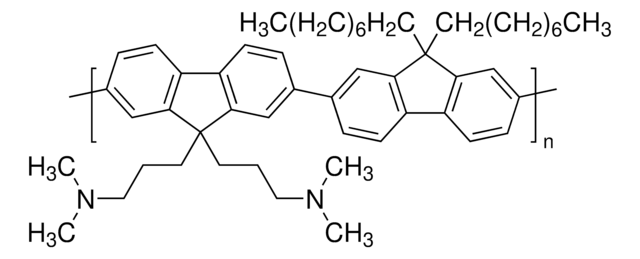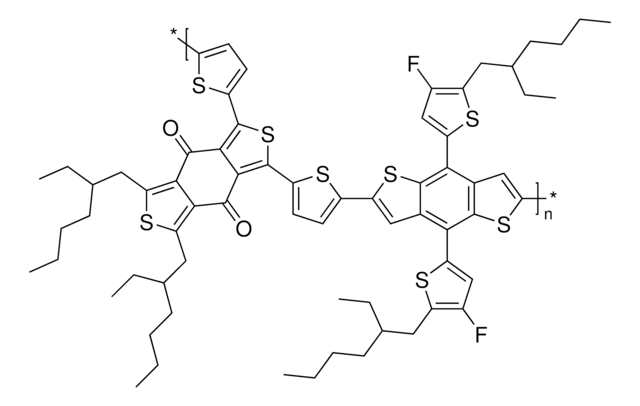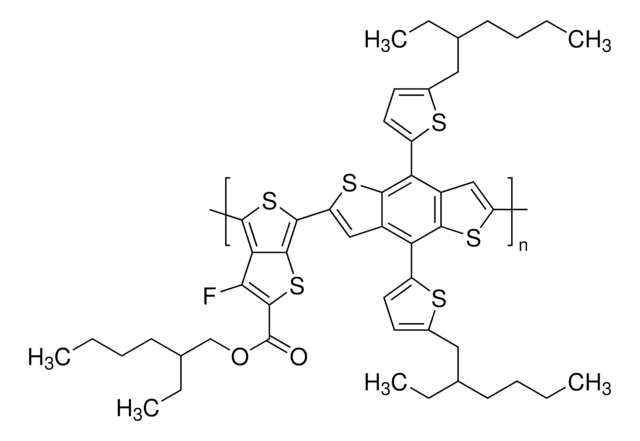906980
PFN-Br
Synonym(s):
OS0995, PFN-P2, Poly(9,9-bis(3’-(N,N-dimethyl)-N-ethylammoinium-propyl-2,7-fluorene)-alt-2,7-(9,9-dioctylfluorene))dibromide
About This Item
Recommended Products
form
solid
mol wt
Mw 30,000-50,000 by GPC
greener alternative product characteristics
Design for Energy Efficiency
Learn more about the Principles of Green Chemistry.
sustainability
Greener Alternative Product
color
beige to yellow
mp
>200 °C
solubility
DMF: soluble
DMSO: soluble
alcohol: soluble
chloroform: insoluble
water: soluble
PDI
2‑3.2
greener alternative category
, Enabling
Looking for similar products? Visit Product Comparison Guide
General description
Application
OPV devices with PFN-Br interfacial layer showed overall enhanced short-circuit current density, open-circuit voltage, fill factor and corresponding high efficiency in the inverted OPVs. This was attributed to the good contact between ZnO electron extraction layer and the active layer, good interface adhesion between the electron extraction layer and active layer, and enhanced charge transport via suppressed bimolecular recombination.
Recent report of OPV with a record energy conversion efficiency of 17.3% also utilized PFN-Br, spin-coated on top of ZnO to improve the interfacial properties.
Tandem Cell Device performance:
ITO/ZnO/PFN-Br/PBDB-T:F-M/M-PEDOT/ZnO/PTB7- Th:O6T-4F:PC71BM/MoO3/Ag
Voc=1.642 V
Jsc=14.35 mA/cm2
FF=73.7%
PCE=17.3%
PFN-Br finds application in a wide range of areas:
- OPV interficial layer (metalic oxide compact layer)
- OLED electron transport layer
- Perovskite solar cells
- Flexible printed electronics
- Cationic polymer electrolyte
- Anion exchange material
- Light emitting electrochemical cells
Other Notes
Storage Class Code
11 - Combustible Solids
WGK
WGK 3
Flash Point(F)
Not applicable
Flash Point(C)
Not applicable
Choose from one of the most recent versions:
Certificates of Analysis (COA)
Don't see the Right Version?
If you require a particular version, you can look up a specific certificate by the Lot or Batch number.
Already Own This Product?
Find documentation for the products that you have recently purchased in the Document Library.
Customers Also Viewed
Articles
Professor Chen (Nankai University, China) and his team explain the strategies behind their recent record-breaking organic solar cells, reaching a power conversion efficiency of 17.3%.
Our team of scientists has experience in all areas of research including Life Science, Material Science, Chemical Synthesis, Chromatography, Analytical and many others.
Contact Technical Service




![[6,6]-Phenyl C61 butyric acid methyl ester ≥99%](/deepweb/assets/sigmaaldrich/product/structures/359/221/d990c746-0960-4c69-bf76-fe09b193824d/640/d990c746-0960-4c69-bf76-fe09b193824d.png)








